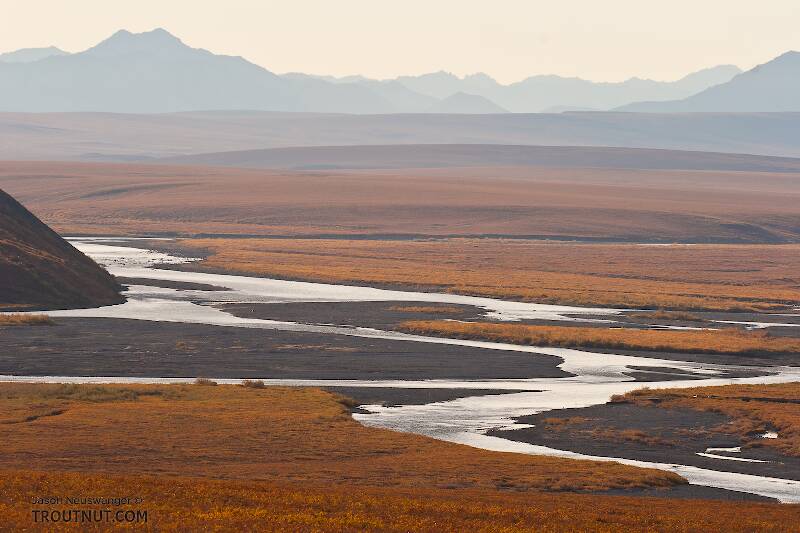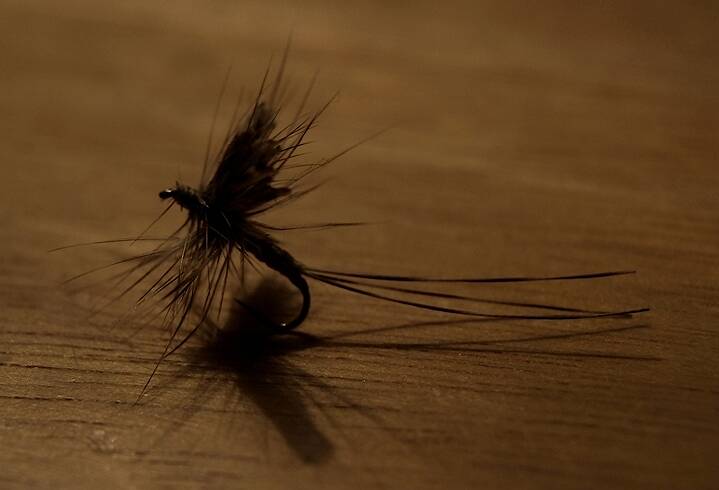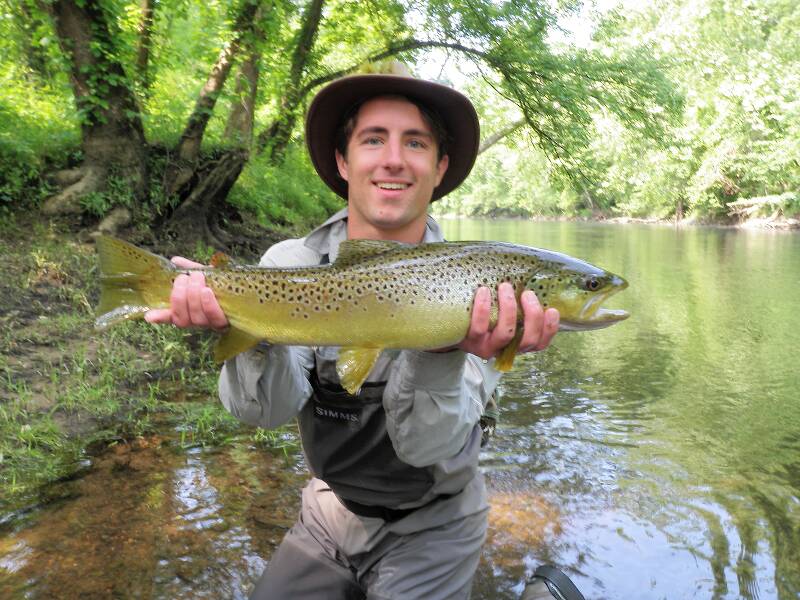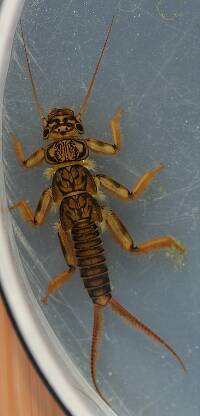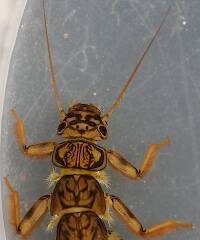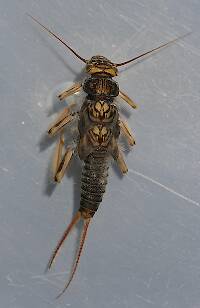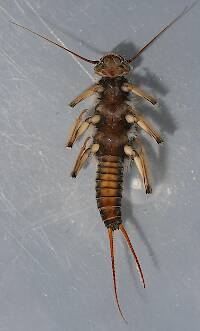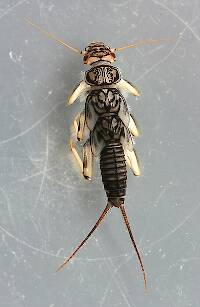
Blue-winged Olives
Baetis
Tiny Baetis mayflies are perhaps the most commonly encountered and imitated by anglers on all American trout streams due to their great abundance, widespread distribution, and trout-friendly emergence habits.
Featured on the forum

As far as I can tell, this species has only previously been reported from one site in Oregon along the Columbia gorge. However, the key characteristics are fairly unmistakable in all except for one minor detail:
— 4 small yellow spots on frons visible in photos
— Narrow occipital spinule row curves forward (but doesn’t quite meet on stem of ecdysial suture, as it's supposed to in this species)
— Short spinules on anterior margin of front legs
— Short rposterior row of blunt spinules on abdominal tergae, rather than elongated spinules dorsally
I caught several of these mature nymphs in the fishless, tiny headwaters of a creek high in the Wenatchee Mountains.
— 4 small yellow spots on frons visible in photos
— Narrow occipital spinule row curves forward (but doesn’t quite meet on stem of ecdysial suture, as it's supposed to in this species)
— Short spinules on anterior margin of front legs
— Short rposterior row of blunt spinules on abdominal tergae, rather than elongated spinules dorsally
I caught several of these mature nymphs in the fishless, tiny headwaters of a creek high in the Wenatchee Mountains.

Troutnut is a project started in 2003 by salmonid ecologist Jason "Troutnut" Neuswanger to help anglers and
fly tyers unabashedly embrace the entomological side of the sport. Learn more about Troutnut or
support the project for an enhanced experience here.
FisherOfMen on Jan 2, 2012January 2nd, 2012, 5:44 pm EST
I regularly fish Little River, NY. It is maybe 15 yards or so across average. That might be off, I'm going from memory. I've heard that in smaller waters you don't need to be so concerned about fly selection, as they can't pick and choose what they're feeding on. So, do I need to have a fly selection that would impress any big brown, or can I get along with, say, five or so basic patterns? I see large mayflies there most times I'm there, and I see empty stonefly casings on the rocks. Can I stick with a few sizes of adams, a few stonefly nymphs, and some misc. like San Juan and hopper?
"Nothing makes a fish bigger than almost being caught." -Author Unknown
All that is necessary for the triumph of evil is that good men do nothing. -Edmund Burke
All that is necessary for the triumph of evil is that good men do nothing. -Edmund Burke
Troutnut on Jan 2, 2012January 2nd, 2012, 9:12 pm EST
You can't determine how many flies you need based on the size of the river alone, except for the very loose rule that in very small streams (like <5 yards across) you rarely need specialized flies. I can think of one or two small ones like that where the fish get really picky, but there's an exception. There are lots of 15-yard streams where the trout can get really picky, though.
It all comes down to what sort of food is in the river, how much food there is, and what the water's like -- how fast, how deep, etc. Generally the fish will be most picky in slower water where food is really, really abundant.
Still, it's hard to tell what you'll need without trying, and a few attractor patterns like the Adams will work most of the time on most rivers. I would suggest that you start out with those. If you keep running into feeding fish that reject your flies consistently, you'll know you need to get more complicated (or improve your presentation). In other words, start simple and build up as needed.
It all comes down to what sort of food is in the river, how much food there is, and what the water's like -- how fast, how deep, etc. Generally the fish will be most picky in slower water where food is really, really abundant.
Still, it's hard to tell what you'll need without trying, and a few attractor patterns like the Adams will work most of the time on most rivers. I would suggest that you start out with those. If you keep running into feeding fish that reject your flies consistently, you'll know you need to get more complicated (or improve your presentation). In other words, start simple and build up as needed.
Jason Neuswanger, Ph.D.
Troutnut and salmonid ecologist
Troutnut and salmonid ecologist
Jesse on Jan 3, 2012January 3rd, 2012, 1:44 pm EST
Jason is definitely right here. You have named a few good patterns that will catch fish on that particular river. You have also started out on the right foot; you've noticed some of the bug activity on the river and your now utilizing that information to try and catch fish. That's great! But you won't always be able to catch trout on those patterns, and if there is diverse aquatic bug life in that stream a wider variety of patterns will be needed. Like Jason said, some small streams (lets say a small ten foot at the widest brookie stream), you could get away with throwing one or two patterns and still be successful. But there are some streams that are small with a wide variety of bugs and the fish will get really choosy. Just keep paying attention as your doing, and slowly build your knowledge. Good start though!
Most of us fish our whole lives..not knowing its not the fish that we are after.
http://www.filingoflyfishing.com
http://www.filingoflyfishing.com
Strmanglr on Jan 4, 2012January 4th, 2012, 11:44 am EST
Start using a net to catch bugs in the water. Keep it with you on your vest, use it when you go out each time. Take a camera with you and take pictures of what you find. RECORD it in something with date, time of day, water temperature. You might jot down a few notes about the weather the week before your catch. It's fun to do, especially if you tie, and it gets you more involved and physically connected to what is going on in your river.
Talk to other people who fish it they very well might be able to tell you the major hatches that take place over the year.
Talk to other people who fish it they very well might be able to tell you the major hatches that take place over the year.
FisherOfMen on Jan 7, 2012January 7th, 2012, 2:26 pm EST
Thanks all! I'll keep this stuff in mind. I just took a fly-tying lesson from a local guide service yesterday and I'm starting to research effective patterns to be ready for any hatch.
Thanks again!
Thanks again!
"Nothing makes a fish bigger than almost being caught." -Author Unknown
All that is necessary for the triumph of evil is that good men do nothing. -Edmund Burke
All that is necessary for the triumph of evil is that good men do nothing. -Edmund Burke
Quick Reply
Related Discussions
Topic
Replies
Last Reply
1
Jan 29, 2016
by Martinlf
by Martinlf
4
Sep 4, 2012
by Entoman
by Entoman
Re: Big Green River, Wisconsin, late September
In the Mayfly Species Baetis brunneicolor by Admiralb
In the Mayfly Species Baetis brunneicolor by Admiralb
1
Sep 30, 2013
by Entoman
by Entoman
1
Mar 9, 2012
by Wiflyfisher
by Wiflyfisher

